Replacing fluorescent lamps with LEDs: the reasons for the replacement, which are better, replacement instructions
Light devices are constantly being improved. This process is easily traceable, starting from the moment the appearance of the “Ilyich’s bulb”. As a result of modernization, in addition to direct incandescent lamps, luminescent options appeared, and in modern conditions the replacement of fluorescent lamps with LED devices is a rather urgent task.
Society strives for the best, and this is obvious. The main criteria for aspirations are convenience, comfort and, of course, economy. But how to make the replacement and what should be remembered? We will consider these issues in detail in our article, we will deal with the features of LED and fluorescent bulbs, their pros and cons.
We also provide recommendations for choosing a suitable light bulb and step-by-step instructions for replacing the device.
The content of the article:
Features of the device of a fluorescent lamp
In order to more clearly understand the society’s desire to replace fluorescent lamps with LED devices, it’s logical to get acquainted with the gas construction more closely.
Indeed, a light device with a luminescent coating is a sealed glass tube, usually filled with mercury vapor.
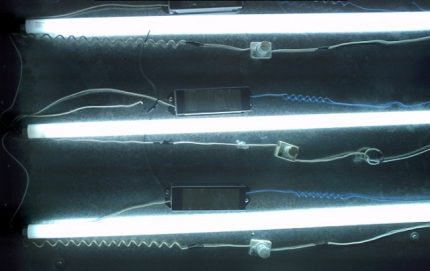
Two modifications of such devices are available:
- For outdoor installation (with high pressure flasks).
- For domestic installation (with low pressure flasks).
In fact, a gas mixture consisting of mercury vapor and argon is present inside the luminescent lamp balloon. From the inside, the walls of the glass flask are coated with a special composition - a phosphor.When an electric discharge is formed in a gaseous medium, a luminescence of gas is formed, and due to the phosphor, this luminescence is transformed into visible light.
In more detail about the device of luminescent we wrote in this article.
The advantages of fluorescent lights
The development and production of luminaires of this type, first of all, were the result of a constant demand for energy savings. We must pay tribute - fluorescent lamps can significantly save.
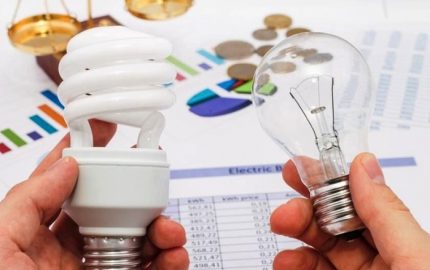
At the same time, it is possible to save due to higher light output of devices, placing a smaller number of devices per unit area in comparison with direct incandescent lamps.
The feasibility of using gas discharge lamps is noted not so much for the domestic sphere as for industrial and economic structures, that is, where it is necessary to cover large areas with minimal costs in terms of energy consumption.
Among the advantages of fluorescent lamps, a decent operational operating time stands out. The average operating time for gas structures is 10,000 hours.

If fluorescent lamps are equated with analogs of direct heat, where the maximum operating time is 1000 hours, the predominant difference becomes more than obvious.
Disadvantages of phosphor-coated light devices
However, the existing advantages of fluorescent lamps, unfortunately, do not hide the obvious disadvantages of these devices. And the main negative here is the increased chemical hazard.
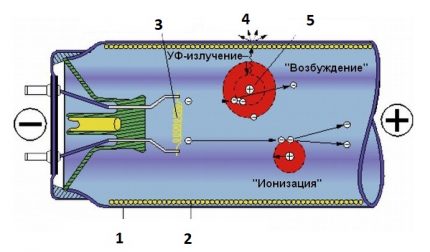
The bottle of each lamp contains at least 2 mg of mercury, and this chemical element is extremely dangerous for a living organism. Of course, while the flask is in an airtight state, the chemical hazard is reduced to zero.
Nevertheless, cases of the battle of glass cylinders of fluorescent lamps are quite common practice. Therefore, it is important to immediately think about the right recycling fluorescent tubes.
Also of the shortcomings should be noted "cold" light and the effect of "gating". Both effects have an adverse effect on vision. That is why fluorescent lamps are not widely used in the domestic sphere. In a word, there was every reason to put an edge on the question of replacing fluorescent lamps. A suitable alternative was found quickly.
LED-based luminaires
An alternative to fluorescent lamps - LEDs - appeared relatively recently and was marked by obvious success from a technical and environmental point of view.
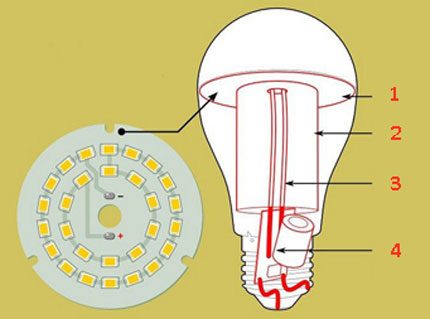
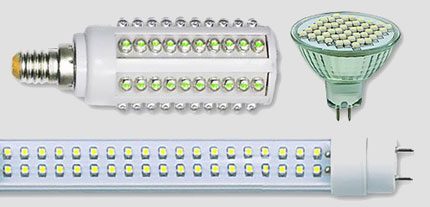
Structure LED based lamps does not imply the presence of any aggressive chemistry, especially harmful to human health. As such, there is no unified design for LED lamps.
On the contrary, this option is “sharpened” for a unique construction design.True, model series are produced, which include lamps somewhat similar to each other, with the exception of small parts.
Technical Comparison
If we compare devices with LEDs with fluorescent lamps in terms of luminous flux efficiency, the first devices are of course inferior. The scattering ability of fluorescent lamps is still observed at a higher level.
Therefore, LED lamps are often used instead of fluorescent as point devices of light. Meanwhile, for domestic conditions, the factor of effective light scattering is usually not dominant.
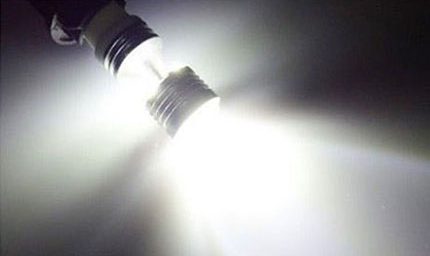
But if you compare the devices according to the degree of energy consumption (power), LED lamps look the most economical of all existing modifications. The same significant advantage of the LED design is declared in terms of durability. Even fluorescent devices with their maximum parameter of 20,000 hours are inferior to LED lamps with their standard of 50,000 hours.
An indisputable advantage is the overall dimensions of LED lamps. Perhaps these are the smallest light devices of all that exist.
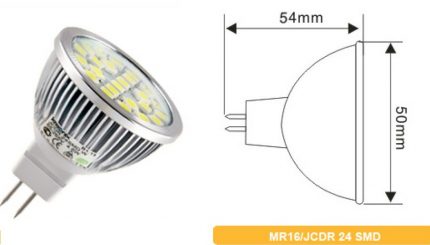
Traditional direct incandescent lamps can still argue in this direction, but the temperature parameters of traditional lamps reduce this dispute to a loss. LEDs heat up slightly (at a normal ambient temperature of 25-27 ºС).
Disadvantages of LED Designs
The list of deficiencies usually consists of three main points:
- gating;
- poor build quality;
- use of substandard parts.
Based on this list, you can understand the significant difference in price, which is often fixed in the market. As a rule, high-quality branded devices have high price tags. But the assortment in the low price category is, most likely, a substandard product.
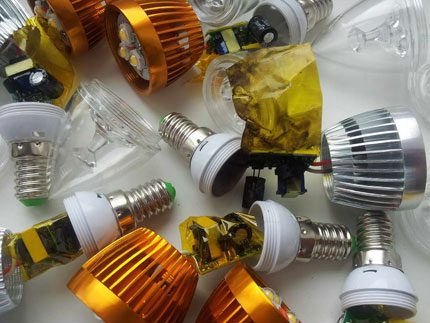
What is fraught with the acquisition of substandard products? In most cases, such lamps “suffer” a gating defect - flicker invisible to the human eye, affecting the brain system. In this case, the LEDs are no different from halogen. As a result, often for users, the case ends with nervous irritability, weakness, and poor health.
Budget devices are assembled from the same inexpensive parts that do not comply with technical standards. In the assembly process, toxic materials are used: lead, phenol, formaldehyde resins.

The conclusion is obvious: if you already buy an LED lamp, saving in this matter is simply inappropriate. In turn, buying an expensive product with eyes closed is also not recommended.
We recommend that you read the rating top led bulbs leading manufacturers of lighting products in the market.
Replacement instructions for LED bulbs
So, if the technical and operational characteristics of LED linear lamps fell to the user's taste and the option of replacing fluorescent devices matured, how to do this?
Conditionally, you can divide the replacement into two options:
- Complete dismantling of the old lamp and installation of a new one.
- Use a halogen chassis for installing the LED.
With the first option it’s clear - you have to remove the old bulbs (lamps), and instead install new ones that work on LEDs.
Why do the following work in sequence:
- turn off the power to the lamp;
- carefully remove the fluorescent lamps and dispose of in accordance with the rules;
- disconnect the power supply line;
- dismantle the chassis;
- install the chassis under the LED lamps;
- connect the power line.
For the second option, a characteristic feature is the selection of LED light devices corresponding to the dimensions of the fluorescent lamps that are supposed to be replaced. It is imperative that cap LED bulbs are also matched (usually type G13 socle).
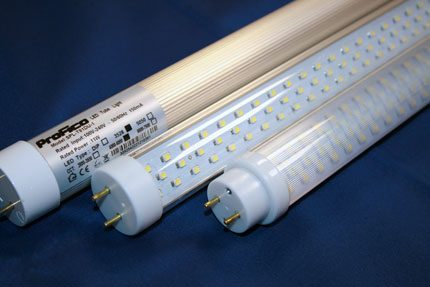
Next, on the old chassis, you must remove the entire auxiliary circuit set: throttle (EMPR), electronic ballasts (in modified designs), starter block, smoothing capacitor.
The power lines of these elements are simply closed. That is, the power to the base of the LED lamp is led directly from the network, bypassing any additional elements.
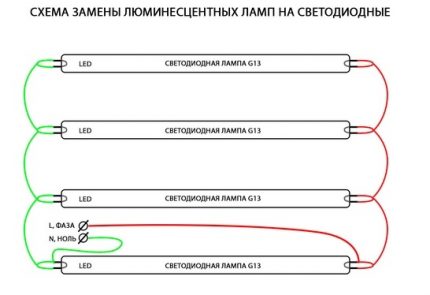
If the chassis is mounted on two or more LED elements, in this case the base pads for each device are connected to the others according to the parallel connection scheme.
Which lamps are best to replace?
It is recommended to use the standard principle, repeatedly verified by the personal experience of many users. The first recommendation is to choose devices from an assortment of well-known manufacturers that guarantee high product quality. Such devices are usually distinguished by high cost, but quickly pay off due to economical energy consumption.
The second selection principle is the number of LED elements per unit area of the lamp working surface. The more LED elements are placed on the surface, the higher the scattering power of the lamp. Therefore, if you need to illuminate a large area of the room, you should choose products with the maximum possible number of LEDs.
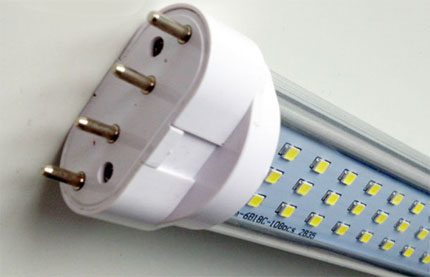
Out of habit, a potential buyer chooses light devices with an eye on the power parameter. In this case, the power is determined in a slightly different way - taking into account the ratio of 1 to 10, when compared with a conventional direct incandescent lamp. For example, if the power of a conventional device is 100 W, then the LED analogue will correspond to 10 watts.
It is also important to focus on the color temperature of the lighting device. We wrote more about this parameter in the next article.
Based on the operating conditions, choose lamps according to protection class. For domestic use, the IP40 class is usually a satisfactory option. For rooms with higher requirements - protection class from 50 and above. More on protection class and value decryption we talked here.
High protection parameters are necessary for luminaires installed in special rooms with explosive environments.
Conclusions and useful video on the topic
The video demonstrates the practice of replacing one type of lamp with another. Sequential actions for the dismantling and installation of work items.
An example that is surely useful for practical application:
If you evaluate the technical characteristics, operating conditions and the operation of devices in everyday life, LED light sources win. They also have their drawbacks, but even if available, they can save energy and serve for a long time.
On an industrial scale, the savings are very significant if you choose reliable bulbs from trusted manufacturers with a good warranty period.
Have experience replacing fluorescent lights with LED bulbs? Please share your opinion in the comments section. Or maybe you still have questions after reading our material? Ask our experts and other site visitors for advice - competent users will be happy to share their experiences with you.

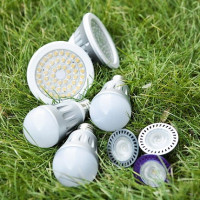 LED lamps for the home: which diode bulbs are better, LED lamp manufacturers overview
LED lamps for the home: which diode bulbs are better, LED lamp manufacturers overview 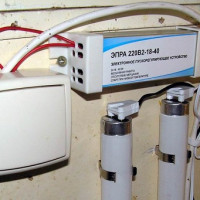 Electronic ballasts for fluorescent lamps: what it is, how it works, wiring diagrams for lamps with electronic ballasts
Electronic ballasts for fluorescent lamps: what it is, how it works, wiring diagrams for lamps with electronic ballasts 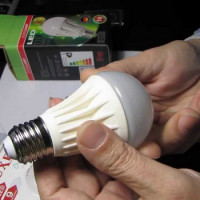 Which LED lamps are better to choose: types, characteristics, choice + best models
Which LED lamps are better to choose: types, characteristics, choice + best models 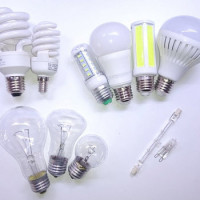 Which bulbs are best for the home: which are + rules for choosing the best bulb
Which bulbs are best for the home: which are + rules for choosing the best bulb 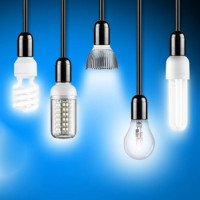 What types of bulbs exist: an overview of the main types of lamps + rules for choosing the best
What types of bulbs exist: an overview of the main types of lamps + rules for choosing the best 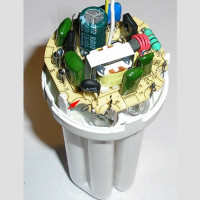 Inductor for fluorescent lamps: device, purpose + circuit for connecting
Inductor for fluorescent lamps: device, purpose + circuit for connecting  How much does it cost to connect gas to a private house: the price of organizing gas supply
How much does it cost to connect gas to a private house: the price of organizing gas supply  The best washing machines with dryer: model rating and customer tips
The best washing machines with dryer: model rating and customer tips  What is the color temperature of light and the nuances of choosing the temperature of the lamps to suit your needs
What is the color temperature of light and the nuances of choosing the temperature of the lamps to suit your needs  Replacement of a geyser in an apartment: replacement paperwork + basic norms and requirements
Replacement of a geyser in an apartment: replacement paperwork + basic norms and requirements
I replaced the luminescent types of bulbs with LEDs in ceiling lights with 4 lamps in the so-called Armstrong lamps. Saving exactly twice. A little had to tinker. The fixtures must be removed the entire starter system and connect the power directly. And then just insert the diode lamp, made under the fluorescent, it is necessary that it be the same size. The only trick is that the bulb is only visually cylindrical in shape, but in fact it has a strip with diodes that shine only in one direction. Therefore, turn the lamp diodes down.